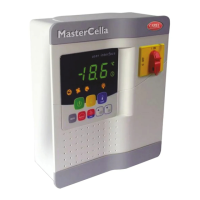25
Sbrinamento
si salta lo sbrinamento previsto si saltano due sbrinamenti previsti
si saltano tre sbrinamenti previsti
dI dI dI dI dI dI dI dI
dI
dI
tempo
dE < dn% dE < dn% dE < dn%
Sbrinamento
si salta lo sbrinamento
lo sbrinamento viene
eseguito regolarmente
si salta lo sbrinamento
dI dI dI dIdI
tempo
dE < dn% dE < dn%dE > dn%
dI
Fig. 6.b
Fig. 6.c
ENGLISH
ir33 +030220441 - rel. 2.0 - 01.05.2006
6.7.3 Defrost at intervals calculated according to the duration of the previous defrost:
Skip defrost
To enable the controller for this operating mode, set the parameter d12=2.
In this case, according to the duration of the last defrost operation, the controller establishes whether the
next defrost is skipped or not.
The following parameters are associated with this function:
• d12: enable the function;
• dI: interval between defrosts;
• dn: nominal duration of the defrost, in proportion to the defrost timeout (value expressed as a %);
• dP1 and dP2: maximum defrost duration for evaporator 1 and 2.
When setting these parameters correctly, the algorithm calculates, using the following formulae:
dn1 dP1
100
dn
and
dn2 dP2
100
dn
.
the nominal defrost times dn1 and dn2 (in the case of the second evaporator) obtained as percentages
dn of dP1 and dP2 This function is based on a very simple but very effective principle. If the defrost lasts
less than or equal to the time dn1 or dn2 (calculated with the formulae shown above), the next defrost
due after the time “dI” will be skipped.
When the next defrost is performed, the check is repeated, and if the outcome is the same, then the
following two due defrosts are skipped, and so on according to the criteria described above (maximum
3 successive defrosts skipped). If 3 consecutive defrosts are skipped and the actual defrosting time is still
less than dn%, the cycle is terminated and the controller will skip one more defrost.
As soon as the defrost time exceeds dn% of the time dP, the next defrost will be performed and the
function will start again.
The algorithm counts the defrosts to be skipped:
• if defrost fi nishes in less time than dn1, the counter of the defrost operations to be skipped is increased
by 1. The current value of the counter indicates the defrost operations to be skipped;
• if the defrost ends normally, the next defrost is performed;
• when the counter reaches the value 3, three defrosts are skipped, and then the counter is reset to 1;
• when the instrument is switched on, the defrost is performed the fi rst 7 times without increasing the
counter, after which the counter can be updated (from the eighth defrost on).
To the side is a graphical description of the function.
This function should be used with the programming of the defrosts equally distributed over the day (e.g.
cyclical defrosts, parameter “dI”). This prevents skipping defrosts that would be the last before a long
period programmed without defrosts (for example, when the clock is used to program the defrosting of
the utility at night only).
6.7.4 Defrost according to the duration of the previous defrost with skip defrost and
variable dI (combination of 1 and 2)
To enable the controller for this operating mode, set parameter d12=3.
In this mode, the controller performs the defrosts considering both the duration of the previous defrost
and the possibility of skipping the defrost, as well as the interval set using parameter dI.
Parameters used:
• dI: interval between defrosts;
• d12: enable the function;
• dn: nominal duration of the defrost, in proportion to the set defrost timeout (value expressed as a %);
• dP1 and dP2: maximum defrost duration for evaporator 1 and 2;
• dH: control proportional factor.
The algorithm uses the following formulae to calculate:
∆dI
dn
100
dI
dH
50
dE
*
dP
the nominal defrost times dn1 and dn2 (in the case of the second evaporator) obtained as percentages
dn of dP1 and dP2
The parameter ‘dH’ is a proportional factor that amplifi es or attenuates the variation of “dIn”. Conse-
quently, in this operating mode, if a defrost lasts less than the time “dn” established, the algorithm will
proportionally add (according to the value assigned to parameter dH) the time remaining from the
previous defrost to the following defrost interval “dI1”. In addition to this, the algorithm will skip, using
the “skip defrost” principle, the next defrost/defrosts depending on the value reached by the skip defrost
counter (from 1 to 3).

